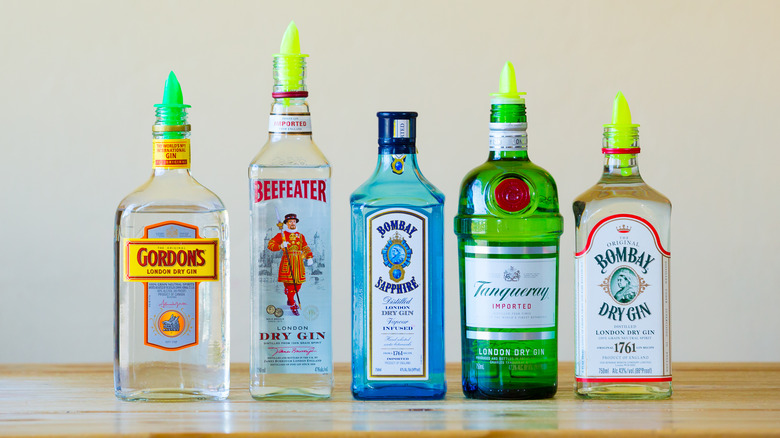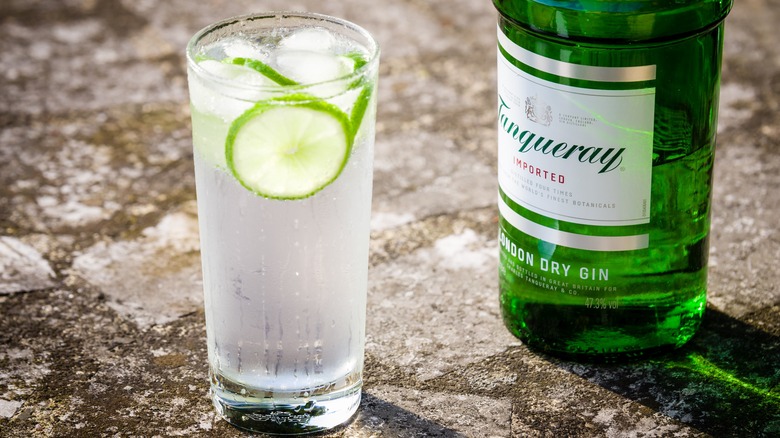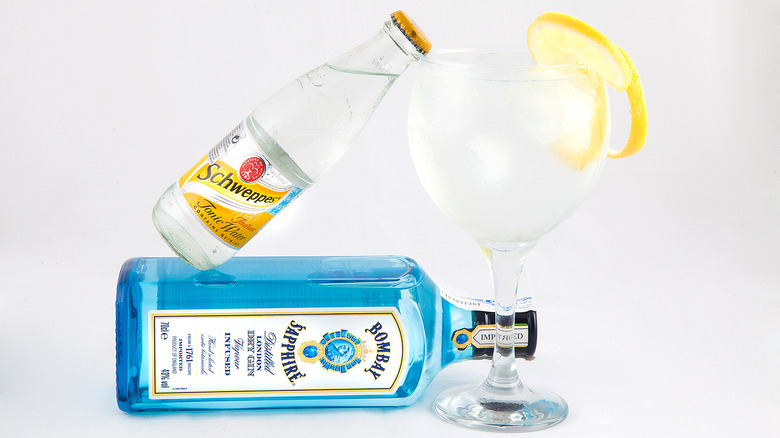Tanqueray Vs Bombay Sapphire: What Makes These Gins Different?
Tanqueray and Bombay Sapphire are often mentioned on lists of the best-selling, most popular gins. These two London-style dry gins are around the same price point, and while both are classic gins — a grain liquor flavored with juniper berries – unique traits make them different. According to Esquire, the rules of London-style gin are that "juniper must be the dominant flavor ... and botanicals must flavor the gin during distillation, with no flavor or color added afterwards." Tanqueray and Bombay Sapphire both adhere to these standards, but they come from different countries, are made using distinct processes, and include different botanical flavorings.
Tanqueray has been making gin since 1830, and is looked to as a timeless classic in the London dry category. To make it, four botanicals are added to a small amount of neutral grain spirit during the first distillation, and then that concentrate is diluted into more of the spirit and distilled again. While the product was originally made in London, it is now produced in Fife, Scotland and owned by Diageo.
Bombay Sapphire was released in 1987. It is based on the recipe for Bombay Original, which came out in the 1950s, though the history of the Bombay distillery goes back to 1761. This gin is flavored through vapor infusion extraction. The botanicals are suspended above the grain spirit, and as the alcohol evaporates during distillation, the vapor passes through the botanicals. It is made in Laverstoke in Hampshire, England and owned by Bacardi.
How do Tanqueray and Bombay Sapphire differ in taste?
If Tanqueray represents the stalwart classic, then Bombay Sapphire represents the new generation of gin, though both are treated as go-to's by many bartenders. Comparatively, the piney juniper flavors are more pronounced in Tanqueray, while Bombay Sapphire has somewhat more subtle and nuanced tasting notes. This is due to the different ways that the botanical flavors are extracted during production of each spirit. The methods used by both brands bring a complexity to the glass, but Tanqueray uses only four botanicals, while Bombay Sapphire uses ten.
Tanqueray London Dry utilizes juniper, coriander seeds, angelica root, and licorice. Angelica root is bitter, herbal, and woody, while licorice is earthy and sweet. Coriander brings toasty notes of citrus and spice. Liquor.com describes Tanqueray as, "Rich and juniper-forward, with notes of pine, pepper, angelica root, lime zest, licorice, and dried orange peel."
Bombay Sapphire has a longer ingredient list that also includes juniper, angelica root, and coriander seeds, but no licorice. The remaining seven botanicals are cassia bark, orris, lemon peel, grains of paradise, cubeb berries, and almonds. Cocktail Society says that Bombay Sapphire is "mild with a gentle heat" and that the "spicy, earthy, and floral notes pair with hints of sweetness, citrus, and juniper."
How to best use Tanqueray and Bombay Sapphire
Compared to other brands, many consider these two gins to be on the strong side when it comes to flavor. That makes both Tanqueray and Bombay ideal for gin fans that love to taste pronounced juniper notes, as well as those of us who like to mix gin cocktails with bold flavors, like a white Negroni, Hanky Panky, or Corpse Reviver No. 2. Keep in mind that in the United States, both Bombay Sapphire and Tanqueray have an alcohol content of 47.3%, while the versions sold in Canadian, European, and Australian markets are less boozy.
Tanqueray shines in classic cocktails like gin and tonics, martinis, gimlets, and gin sours, as well as any sort of citrusy concoction. Because of its richness, it pairs especially well with sharp lime juice for a bit of balance, like in a gin rickey recipe. Bombay Sapphire is also lovely in classic gin cocktails, and is a better choice for those who love those botanical notes delivered a bit more delicately. A bottle of Bombay may also be a good gin entry point if you tend to be more of a neutral vodka drinker. Fresh lemon and mint make for a particularly complimentary garnish on a Bombay Sapphire gin and tonic.



